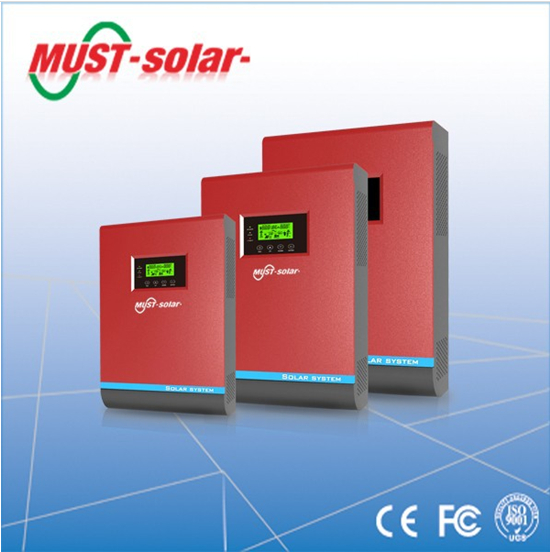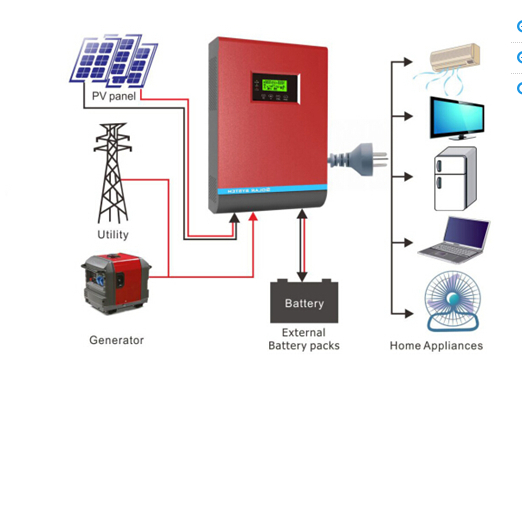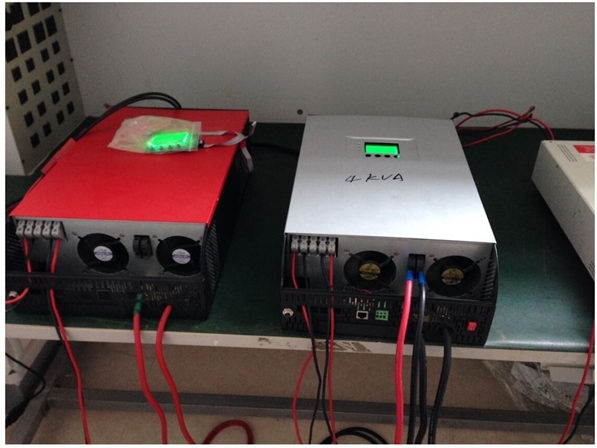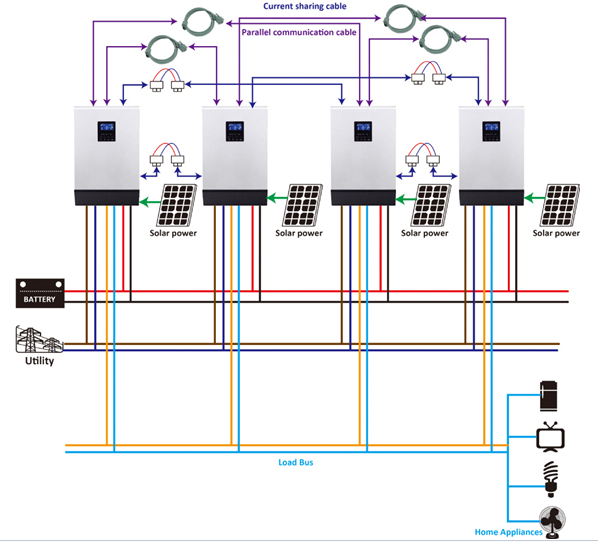Solar Inverter off Grid 1kva -5kva Built in 50APWM 60AMPPT Charge Controller Parallel Function
- Loading Port:
- China main port
- Payment Terms:
- TT or LC
- Min Order Qty:
- 1500 watt
- Supply Capability:
- 3000000 watt/month
OKorder Service Pledge
OKorder Financial Service
You Might Also Like
1. Structure of Solar Inverter Off Grid 1kva -5kva Built in 50APWM 60AMPPT Charge Controller Parallel Function Description
A solar inverter, or PV inverter, or Solar converter, converts the variable direct current (DC) output of a photovoltaic (PV) solar panel into a
utility frequency alternating current (AC) that can be fed into a commercial electrical grid or used by a local, off-grid electrical network. It is
a critical BOS–component in a photovoltaic system, allowing the use of ordinary AC-powered equipment. Solar inverters have special
functions adapted for use with photovoltaic arrays, including maximum power point tracking and anti-islanding protection.
2. Main Features of Solar Inverter Off Grid 1kva -5kva Built in 50APWM 60AMPPT Charge Controller Parallel Function
• Pure sine wave inverter
• Selectable input voltage range for home appliances and personal computers
• Selectable charging current based on applications
• Configurable AC/Solar input priority via LCD setting
• Compatible to mains voltage or generator power
• Parallel operation with up to 4 units only available for PV200 4KVA/5KVA
• Auto restart while AC is recovering
• Overload and short circuit protection
• Smart battery charger design for optimized battery performance
• Cold start function
3. Solar Inverter Solar Inverter Off Grid 1kva -5kva Built in 50APWM 60AMPPT Charge Controller Parallel Function Images




4. Solar Inverter Off Grid 1kva -5kva Built in 50APWM 60AMPPT Charge Controller Parallel Function Specification
RATED POWER | 1000VA / 800W | 2000VA/ | 3000VA / 2400W | 4000VA / 3200W | 5000VA / 4000W |
1600W | |||||
INPUT | |||||
Voltage | 230 VAC | ||||
Selectable Voltage Range | 170-280 VAC (For Personal Computers) ; 90-280 VAC (For Home Appliances) | ||||
Frequency Range | 50 Hz/60 Hz (Auto sensing) | ||||
OUTPUT | |||||
AC Voltage Regulation | 230 VAC ± 5% | ||||
(Batt. Mode) | |||||
Surge Power | 2000VA | 4000VA | 6000VA | 8000VA | 10000VA |
Efficiency (Peak) | 90% | 93% | |||
Transfer Time | 10 ms (For Personal Computers) ; 20 ms (For Home Appliances) | ||||
Waveform | Pure sine wave | ||||
BATTERY | |||||
Battery Voltage | 12 VDC | 24 VDC | 48 VDC | ||
Floating Charge Voltage | 13.5 VDC | 27 VDC | 54 VDC | ||
Overcharge Protection | 15 VDC | 30 VDC | 60 VDC | ||
Maximum Charge Current | 10 A or 20 A | 20 A or 30 A | 60 A | ||
SOLAR CHARGER (OPTION) | |||||
Charging Current | 50 A | ||||
Maximum PV Array Open Circuit Voltage | 30 VDC | 60 VDC | 105 VDC | ||
Standby power Consumption | 1 W | 2 W | 2 W | ||
PHYSICAL | |||||
Dimension, D x W x H (mm) | 95 x 240 x 316 | 100 x 272 x 355 | 125 x 297.5 x 468 | ||
Net Weight (kgs) | 5 | 6.4 | 6.9 | 9.8 | 9.8 |
OPERATING ENVIRONMENT | |||||
Humidity | 5% to 95% Relative Humidity(Non-condensing) | ||||
Operating Temperature | 0°C - 55°C | ||||
Storage Temperature | -15°C - 60°C | ||||
5. FAQ of Solar Inverter Off Grid 1kva -5kva Built in 50APWM 60AMPPT Charge Controller Parallel Function
Q1:Can we visit your factory?
A1:Sure,welcome at any time,seeing is believing.
Q2:Which payment terms can you accept?
A2:T/T,L/C,Moneygram,Paypal are available for us.
- Q:Are there any noise or sound considerations with a solar inverter?
- Yes, there are generally no noise or sound considerations with a solar inverter. Solar inverters are designed to operate silently, without producing any noticeable noise or sound. This is because they use solid-state electronics, which do not have any moving parts that can generate noise.
- Q:Can a solar inverter be used with different types of monitoring systems?
- Yes, a solar inverter can be used with different types of monitoring systems. Solar inverters are designed to convert the direct current (DC) electricity produced by solar panels into alternating current (AC) electricity that can be used in homes or businesses. While some inverters come with built-in monitoring systems, they can also be connected to external monitoring systems that provide more advanced data and analytics. This allows users to monitor and manage their solar power generation and consumption effectively, regardless of the monitoring system they choose to use.
- Q:What is the difference between a PV inverter and a solar inverter?
- Instability, the wind speed and the equipment itself will directly affect the generator rotation, so the voltage and current fluctuations, frequency instability, in short, is the power quality is poor) Therefore, through the inverter after the first rectification inverter to improve the quality of power
- Q:Can a solar inverter be used with solar-powered greenhouse systems?
- Yes, a solar inverter can be used with solar-powered greenhouse systems. A solar inverter is an essential component in converting the direct current (DC) generated by solar panels into alternating current (AC) that can be used to power electrical devices. By installing a solar inverter, the solar energy collected by the greenhouse's solar panels can be efficiently converted and utilized to power various equipment and systems within the greenhouse, ensuring an environmentally friendly and sustainable energy source.
- Q:What is the typical size and weight of a solar inverter?
- The typical size and weight of a solar inverter can vary depending on the capacity and type of the inverter. However, most residential solar inverters have dimensions ranging from around 12 x 8 x 5 inches and weigh between 20 to 40 pounds. Commercial or utility-scale inverters can be much larger and heavier, often weighing several hundred pounds and having larger dimensions.
- Q:What is the maximum input voltage that a solar inverter can handle?
- The maximum input voltage that a solar inverter can handle depends on the specific model and make of the inverter. It can vary widely, but typically ranges between 600V to 1000V DC for residential inverters, and higher for commercial or utility-scale inverters.
- Q:Can a solar inverter be used with electric vehicles?
- No, a solar inverter cannot directly be used with electric vehicles. Solar inverters are designed to convert DC (direct current) from solar panels into AC (alternating current) for home or grid use. Electric vehicles, on the other hand, require DC power to charge their batteries. However, solar energy generated through a solar inverter can be used to charge the batteries of an electric vehicle indirectly by connecting the solar system to the power grid or using a separate charging station equipped with a suitable DC charger.
- Q:Can a solar inverter be used with a solar-powered remote sensing system?
- Yes, a solar inverter can be used with a solar-powered remote sensing system. The solar inverter is responsible for converting the direct current (DC) generated by the solar panels into alternating current (AC) that can be used to power the remote sensing system.
- Q:Can a solar inverter be used in a solar-powered data center?
- Yes, a solar inverter can be used in a solar-powered data center. A solar inverter is an essential component of a solar power system as it converts the direct current (DC) generated by solar panels into alternating current (AC) that can be used to power electrical devices in a data center. By using a solar inverter, a solar-powered data center can efficiently utilize the electricity generated from solar panels to meet its power requirements.
- Q:How does a solar inverter handle voltage and frequency variations caused by switching operations?
- Through its built-in control mechanisms and advanced technology, a solar inverter is specifically designed to handle voltage and frequency variations resulting from switching operations. When connected to the grid, the solar inverter actively monitors the grid's voltage and frequency, and adjusts its operation accordingly to ensure stability and safety. When voltage variations occur due to switching operations, a solar inverter typically employs a voltage control mechanism. This mechanism continuously monitors the grid's voltage level, and accordingly adjusts the inverter's output voltage to match the grid voltage. If the grid voltage exceeds or falls below a specific threshold, the inverter automatically compensates by adjusting its output voltage to maintain a stable level. Similarly, for frequency variations caused by switching operations, a solar inverter utilizes a frequency control mechanism. This mechanism constantly monitors the grid's frequency and adjusts the inverter's output frequency to match the grid's frequency. If the grid's frequency deviates from the standard, the inverter promptly responds by adjusting its output frequency to ensure synchronization with the grid. To achieve precise control, solar inverters often integrate advanced digital signal processing algorithms and sophisticated control systems. These algorithms and control systems analyze the voltage and frequency signals from the grid, and based on predefined parameters, swiftly make adjustments to the inverter's output. This ensures compatibility with the grid and promotes seamless integration. Ultimately, the primary objective of a solar inverter is to seamlessly integrate with the grid, providing a stable, reliable, and efficient power supply. By effectively managing voltage and frequency variations resulting from switching operations, the inverter plays a crucial role in maintaining the overall stability and resilience of the grid. This allows for optimal utilization of solar energy and contributes to a sustainable energy future.
1. Manufacturer Overview |
|
|---|---|
| Location | |
| Year Established | |
| Annual Output Value | |
| Main Markets | |
| Company Certifications | |
2. Manufacturer Certificates |
|
|---|---|
| a) Certification Name | |
| Range | |
| Reference | |
| Validity Period | |
3. Manufacturer Capability |
|
|---|---|
| a)Trade Capacity | |
| Nearest Port | |
| Export Percentage | |
| No.of Employees in Trade Department | |
| Language Spoken: | |
| b)Factory Information | |
| Factory Size: | |
| No. of Production Lines | |
| Contract Manufacturing | |
| Product Price Range | |
Send your message to us
Solar Inverter off Grid 1kva -5kva Built in 50APWM 60AMPPT Charge Controller Parallel Function
- Loading Port:
- China main port
- Payment Terms:
- TT or LC
- Min Order Qty:
- 1500 watt
- Supply Capability:
- 3000000 watt/month
OKorder Service Pledge
OKorder Financial Service
Similar products
New products
Hot products
Hot Searches
Related keywords





























